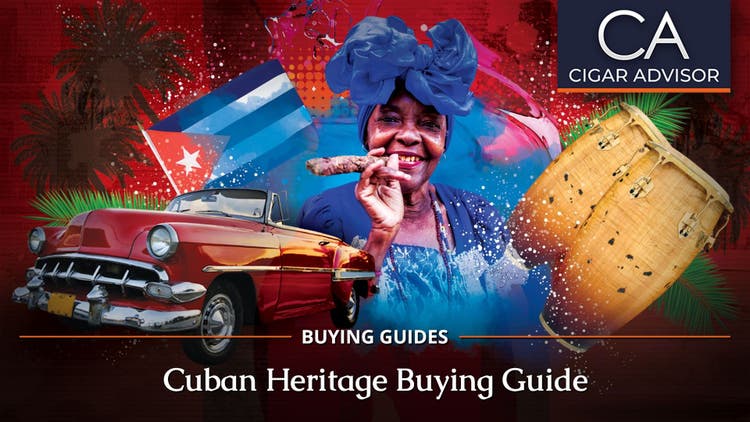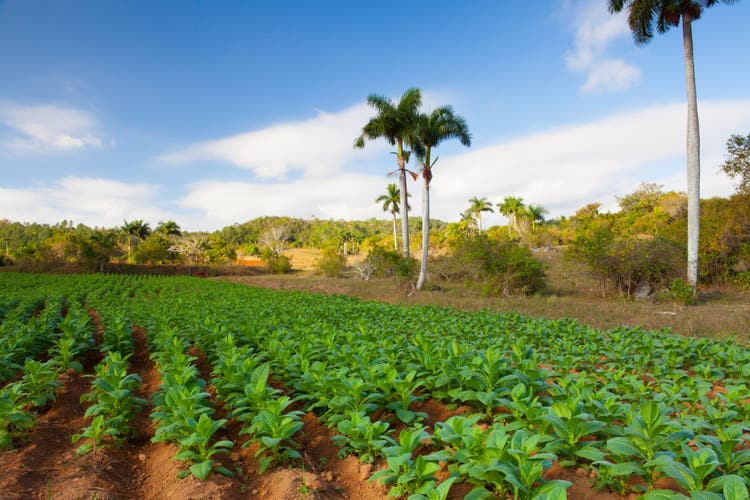
Cuban Heritage Cigars Buying Guide
Cuban Heritage Cigars: How Castro’s Communist Revolution Created a New Cigar Industry
Updated May 2023
THE NAMES ARE FAMILIAR to every savvy cigar smoker: Partagas, Montecristo, Romeo y Julieta, H. Upmann, Cohiba. They’re all identified with Cuba’s “Golden Age,” when cigars were king and Havana was the brightest star in the Caribbean.
Then, in January 1959, tragedy struck. Fidel Castro’s Communist Revolution forced Cuban presidente Fulgencio Batista out and soon began nationalizing the tobacco farms. Families like Toraño, Plasencia, Perdomo, Oliva, Perez-Carrillo, Eiroa, Padrón and many others had little choice but to leave Cuba and their laboriously-earned assets behind. Many left with little more than the shirts on their backs and loose change in their pockets. Generations of master tobacco growers and cigar makers were uprooted taking their talent and often their seeds to The Dominican Republic, Honduras and Nicaragua.

Fortunately, the aforementioned families had the last laugh. By the mid-1960s, not only did they begin building a budding new cigar industry, but by the mid-1990s they took it to even greater heights. Today many expatriate Cuban families and their offspring are producing cigars that have not only equaled the quality and flavor of Cuban cigars but have far exceeded expectations.
As a result, the Cuban heritage brands listed here have been reinvented, and in most cases become as lauded and coveted as their Cuban originals. Through the use of agricultural science, hybrid seeds have emerged. Micro-climates and myriad soils in places like Nicaragua and the Dominican Republic have produced richer and more versatile tobaccos. Moreover, these post-revolution brands have split into dozens of line extensions with even more ambitious blends. You’ll find many of them here. Although some come close to reviving the so-called, “classic Cuban cigar character,” others demonstrate to what limits and beyond tobacco blending can go.
You’ve got to love the irony, too, but don’t dare thank Fidel who is gone (thankfully). Thank the Cuban heritage cigar makers and their families who through sheer passion, resilience, and resourcefulness found a way to continue their traditions and profit by them.
Bolivar Cofradia Toro
This affordably-priced Bolivar Cofradia line was created by the late, great master blender, Estelo Padrón. Skillfully rolled in a dark, oil-rich Ecuador Sumatra wrapper, the Honduran and Nicaraguan core blend issues a rich, spicy, medium-bodied smoke underscored by sweet cedary notes. At a glance, these tasty under-the-radar cigars really look like their Cuban cousins, too. To tell or not to tell… that’s up to you.
Cohiba Blue
Cohiba Blue is just one of the many Cohiba cigars made by STG outside of Cuba. They’re extremely popular, too. Medium in body, a splash of Nicaraguan Ometepe in the filler gives this blend a somewhat spicier profile. Perfectly-aged Honduran and Dominican tobaccos complete the core capped by an Honduran Olancho San Agustin Rosado wrapper. The result is a well-rounded smoke that’s creamy, complex, and humidor-worthy.
Fonseca by My Father
Leave it to the talented hands at My Father Cigars to turn a Cuban legend into a Nicaraguan classic. Skillfully rolled in a blushing Corojo Rosado wrapper, these Fonsecas are Nicaraguan to the hilt. Medium in body like the former Quesada-made blend, these puros issue a well-balanced and rich-tasting fusion of savory spices, earthy tones, and a refined sweetness. Reasonably-priced, too.
Gispert
Dating back to 1940s Cuba, Gispert—pronounced, “heese-pair”—has had a reputation for being lighter in strength. That’s pretty much the deal with this Honduran-made Gispert. It’s a well-crafted line and a bargain at today’s prices. The cigars are blended with a Honduran-Nicaraguan core neatly rolled in a silky Ecuador Connecticut Shade wrapper. Toasty, woody, a little nutty and sweet, the flavor profile isn’t all that far-off from some mellow Havanas.
H. Upmann by AJ Fernandez
Because there are several H. Upmann cigar blends by AJ Fernandez, that makes it hard to choose a recommendation. Let’s look at it this way. Like most Rock artists, the first album is usually the most definitive; same goes for these first H. Upmann by AJ Fernandez cigars. It’s the one fans seem to remember most fondly (although the new Heritage line is catching-up fast). Using a stunning Criollo and Corojo-forward blend with a sumptuous Ecuador Sumatra wrapper, AJ created a refined, medium-full smoke that unearthed new territory for both old and new H. Upmann fans.
Hoyo de Monterrey
The ability to re-invent a brand in Honduras that originated in 1865 Cuba is another tip of the hat to the late Estelo Padrón. Medium to full in body—depending on size—the Rothschilds Maduro (shown) in a dark, oily Connecticut Broadleaf has become a classic. Desirably affordable and consistent, the smoke draws effortlessly issuing well-defined notes of cedar, roasted nuts, and sweet tobacco for a Havana-rivaling experience.
La Gloria Cubana Medio Tiempo
This is usually where we feature the La Gloria Cubana Wavell, which you could call “the flagship cigar” of the first Dominican-made La Glorias. So, for a change of pace let’s look at the Medio Tiempo selection that showcases Connecticut Havano medio tiempo filler. Added to the Honduran, Dominican, and Nicaraguan core, these rare, sun-soaked leaves add some impressive depth and sweetness to this blend. Finished in Ecuador Sumatra wrappers, this full-production line is also impressively affordable.
Los Statos Deluxe
The pre-Cuban Revolution Los Statos brand re-surfaced in the U.S. during the 1980s for the American market and eventually fell off the radar. Several decades later, with some blending magic by Justin Andrews and Matt “Room101” Booth, Los Statos Deluxe has become a welcome and reasonably-priced hit. Using Ecuador Sumatra wrappers over proprietary Nicaraguan and Dominican fillers, the medium-bodied smoke reveals a creamy serving of woody, spicy, and sweet treats.
Montecristo 1935 Anniversary Nicaragua
The 1935 Anniversary selection from Montecristo has done the almost impossible. AJ Fernandez, the Grupo de Maestros, and Rafael Nodal have created a full-bodied, “first-ever interpretation of the original 1935 blend” (a Cuban!), using all Nicaraguan tobaccos grown on AJ’s estate farms. The blend is undisclosed, but it earned the soft-pressed No. 2 (shown) a “classic” 95-rating and made Aficionado’s #2 cigar of 2021. Earth, leather, pepper, espresso, and sweet spices lead the charge in this line that includes a memorable smoke in every size.
Partagas Heritage
The fact that they look a lot like a Cuban Partagas Serie D cigars at a glance is more of a salute to this historic Cuban brand than an imitation. Partagas master blender Jhonys Diaz and his team created the blend years ago waiting for a future special release and it was well worth the wait. These Dominican-made cigars boast tobaccos that have been highlights of past Partagas bestsellers. An Honduran Olancho San Agustin estate-grown wrapper and a Connecticut Broadleaf binder surround vintage Jamastran, Piloto Cubano, and San Andrés fillers. Well-balanced and complex, the medium-bodied smoke reveals flavors of cedar, dark chocolate sweetness, roasted coffee beans, and earthy spices for a must-try experience.
Punch Gran Puro
The Punch Gran Puro line takes a cue from its Cuban roots by using tobaccos all from the same country; in this case, Honduras. It begins with a proprietary Cuban-seed wrapper grown in Honduras’ St. Augustin valley. The core tobaccos come from other regions of the country. All together they combine for a full-bodied smoke with a flavorful shot of “Vitamin N.” (The 93-rated Santa Rita is one of the brighter stars in the line.) As trusty Honduran puros go, Punch Gran Puro is one of the leaders, not to mention one of the most affordable brands out there.
Romeo House of Romeo
Made exclusively for Famous Smoke Shop, the Romeo y Julieta House of Romeo cigars are among the most impressive in the now six-blend Romeo “House Of” collection. Blended by the Grupo de Maestros and Rafael Nodal, the perfectly cured and aged Ecuador Habano wrappers alone is worth the price of these savory smokes. Rich, chewy and medium-bodied, flavors of dried fruit, earthy spice, nutmeg, and sweet tobacco combine for a refined Romeo that will satisfy even the most critical cigar passionado.
Sancho Panza Double Maduro
The Honduran-made Sancho Panza cigars are another “tried and true” line that seem to have sort of an underground following, but that may be about to change. Since they introduced the revamped Sancho Panza blends last year (Matt Booth at the helm here again), the affordably-priced Double Maduro selection has been especially outstanding. A dark, shimmery, sun-grown Ecuador Sumatra wrapper caps a Nicaraguan-forward core blend for a smoke that’s uber-creamy, medium-bodied, and loaded with sweet-spicy flavors. Maduro lovers may actually go mad for these.
Trinidad Estelí by Plasencia
Talk about a dark horse candidate, this Plasencia creation is among the best of the non-Cuban-made Trinidad cigars. No disrespect to the Trinidad Espiritu and Espiritu No.2 cigars, which are also excellent, but this one’s unique. Rolled in a 2010 vintage Jalapa Habano over a 2009 Jalapa Habano binder and 2008 vintage fillers from Nicaragua’s three primary regions, the result is a velvety medium-bodied smoke issuing standout flavors of cedar, nutmeg, caramel, coffee bean, and dried fruit. A satisfying everyday smoke, Trinidad Estelí does justice to the Trinidad brand which, in its Cuban heyday was considered a “unicorn.”
We should be grateful to the throng of expatriate Cuban cigar makers who continue to hold the flavor and character of Cuban cigars close to their heart. As one expatriate master blender once told me, “It’s in our DNA.” In doing so, these Cuban heritage cigars, not to mention the myriad other brands made outside of Havana today, have leveled the playing field. So, when someone asks, “Are Cuban cigars the best cigars?” you can say: “With all due respect to Cuba, they were, once upon a time.”













